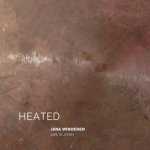
Jana Winderen Heated: Live in Japan
(Touch)
I think there is a common intuition among many drone, ambient and minimal artists that drives them towards the sounds of nature generally. A sort of unspoken acknowledgement that, no matter what the artist's chosen instruments or where he plans to take the music, he owes a solid chunk of what he is doing to the sounds produced by the world around him. Evidence of this is abundantly clear on even one's first survey of the world of drone. Field recordings are hotter property than ever before, artists are reveling in more and more primitive recording techniques, and you cannot get through even the shortest blurb of a review of a drone album without encountering the word “glacial” or a reference to tectonic plates. On this second release from Norwegian “sound recordist” Jana Winderen, this sentiment is brought to it's logical extreme, or at least one of them.
Winderen, performing here live at Super Deluxe in Tokyo, bases her performance off of a series of field recordings she had done on various research trips she has taken. I use the term field recording somewhat loosely here, because what Winderen is doing seems to demand a more exacting term. Going far beyond leaving a couple mics in the woods or on the porch during a thunderstorm, Winderen utilizes seriously cutting-edge technology to milk all the possible sound out of some remarkably curious sources. Winderen sends her various recording devices on profoundly strange pilgrimages to the most utterly alien of locales (specifically, the depths of the ocean, literal glacial caverns and the like) documenting the experience in sound, creating a sort of aural map of the space around them.
A largely superfluous and borderline frustrating spoken Japanese introduction leads us into the track itself. Once we get there, though, I do not feel that I am exaggerating when I say that these recordings might as well be from Mars or even further. The sounds that are played back for us perpetually tease with the possibility of intelligibility before suddenly morphing into something that blatantly announces itself as purely “other” to our experience. Footholds are extended and withdrawn before we even can even register them cognitively. The sounds are often complexly layered upon themselves multiple times; yawning, abysmal caverns create sound by their sheer space while what sounds like organic matter skitters around it's edges before being snuffed out in a loud snap or crackling. Waves turn into feet in a swamp, which turn into brittle, flaking tones over the course of a few seconds. A world that is as vast and terrifyingly gaping as humanly imaginable, yet one that inextricably compresses itself down to the minimal space possible. Watching specials on deep ocean life on the Discovery Channel is certainly one thing, but something about Winderen's audible reconstruction brings home the physicality of the space much more potently and renders it manifoldly less fathomable.
I read somewhere that we know more about the surface of Venus percentage-wise than we do about the deepest parts of our own oceans. I feel that the idea behind this release is, in that vein, one of perspective. Somehow, we are brought back to terms with our status as it relates to these expanses in our own world, that is, a relationship of total non-comprehension. However, the hope of Winderen is, I believe, to also offer us the most approximate of delineations, allowing us to at least begin a deeper process of exploration.
12 February, 2009 - 08:17 — Gabriel Keehn